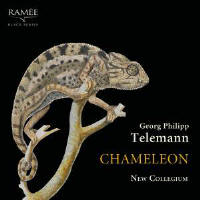Texte paru dans: / Appeared in: Ramée |
|
|
Reviewer: Raymond
Tuttle This lovely disc is named Chameleon because “No eighteenth-century composer was so adept at so many styles as Georg Philipp Telemann.” (A period print of a handsome chameleon is reproduced on the cover.) New Collegium has chosen a program that showcases “the breadth of his musical palette.”Although the ensemble plays the music with a keen sense of period style, its approach to that has not been overly scholarly. One notes the disc’s “palindromic” structure (for example, isolated quartet movements begin and end the program) and the selection of eight disparate movements that have been pulled together to form a home-grown suite from Der getreue Music-Meister.
New Collegium was formed in 2006, and originally was known as Collegium Musicum den Haag. On this recording, its members are Inês d’Avena (recorders), Sara deCorso and Antina Hugosson (violins), John Ma (viola), Rebecca Rosen (cello), and Claudio Ribeiro (harpsichord and musical direction). The core musicians are Ribeiro, d’Avena, deCorso, and Rosen. This is their third CD. Earlier discs have been devoted to C. P. E. Bach (Empfindsam) and to a mixed program of Baroque composers (L’Europe réunie). The latter was enthusiastically reviewed in these pages, finding its way onto Laura Rónai’s Want List in 2008. This new disc was awarded a “Gold Tuning-Fork” by the French music journal Diapason. The ensemble’s timbre is warm and somewhat dark, and there is a terrific sense of teamwork in all of these finely balanced performances.
I found all of these works enjoyable, and both sensitively and imaginatively played by New Collegium. The last movement of the aforementioned suite, a Pastourelle, opens with delightful riffing from the harpsichord. Both drone and shepherd’s pipe effects are then added. The effect is charming, like a day in the country, and with just enough of a sheep manure odor to keep things real. I also liked the Aria from the Concerto à 3 in A Major very much. In this movement, just one of the scordatura violins steps to the fore, and it sings mellowly over a plucked and strummed (it sounds like the harpsichord is being played with a lute stop) accompaniment. This movement comes off as a four-minute sigh of relief. One wonders if Mendelssohn knew the Quartet in G Minor, because that work opens with an Allegro whose theme is similar to the opening of the Scherzo movement from Mendelssohn’s Octet for Strings.
| |
|
|
|
|
|
|
|
Cliquez l'un ou l'autre
bouton pour découvrir bien d'autres critiques de CD |
|




